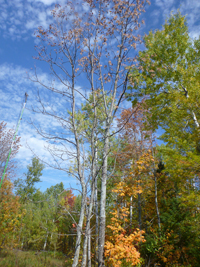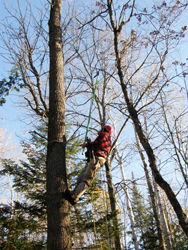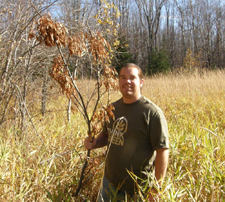Ash Seed Collection
 Ash has cultural and historical significance for the Anishanabe. The "Legend of the Black Ash Basket" (Mike Jacobs) tells of the people's responsibility to watch over the tree and protect it from harm and what is offered in return. Ash was one of the woods used for pictography and family totems. It is used in medicine and some everyday items such as snowshoes, sleds, bows, cradleboards, and flutes. One of the newer uses of this wood is in the making of baseball bats. The identifying, locating, and protecting culturally significant plants is recognized as part of this holistic approach to resource management outlined in the KBIC Integrated Resource Management Plan (2003).
Ash has cultural and historical significance for the Anishanabe. The "Legend of the Black Ash Basket" (Mike Jacobs) tells of the people's responsibility to watch over the tree and protect it from harm and what is offered in return. Ash was one of the woods used for pictography and family totems. It is used in medicine and some everyday items such as snowshoes, sleds, bows, cradleboards, and flutes. One of the newer uses of this wood is in the making of baseball bats. The identifying, locating, and protecting culturally significant plants is recognized as part of this holistic approach to resource management outlined in the KBIC Integrated Resource Management Plan (2003).
Collection of ash seed is also ongoing in an effort to preserve and protect the ash resource in our area from the threat of the emerald ash borer. The Natural Resource Department is a partner in a cooperative effort with BIA Forestry and USDA Natural Resources Conservation Service for collecting local native ash seed. Collections have been completed from locations on approximately 96 acres of tribal land.
 An agreement with the USDA Agricultural Research Service in Colorado provides for long term cold-storage of ash seed collected from KBIC lands. The agreement prohibits any genetic alteration or other use of the ash seed without KBIC approval. The Department of Agriculture continues to monitor for the presence of emerald ash borer in our area. One of the ways we can help reduce the spread of emerald ash borer is to stop the transportation
An agreement with the USDA Agricultural Research Service in Colorado provides for long term cold-storage of ash seed collected from KBIC lands. The agreement prohibits any genetic alteration or other use of the ash seed without KBIC approval. The Department of Agriculture continues to monitor for the presence of emerald ash borer in our area. One of the ways we can help reduce the spread of emerald ash borer is to stop the transportation  of firewood onto or out of tribal lands.
of firewood onto or out of tribal lands.
